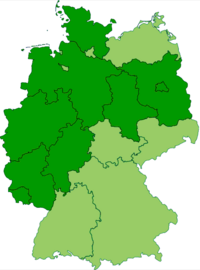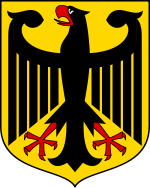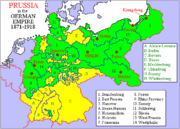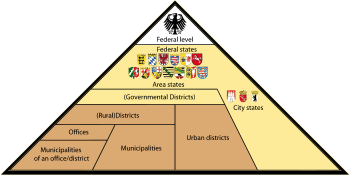States of Germany
Germany (Deutschland) is a Federal Republic consisting of sixteen states, known in German as Länder (singular Land). Since Land is the literal German word for "country", the term Bundesländer (federal states; singular Bundesland) is commonly used colloquially, as it is more specific, though technically incorrect within the corpus of German law.
The citizens of the states form the nation of Germany, and have the right of abode within the states. The area covered by the 16 states is completely and solely the territory of Germany. The governments of the states form part of the government of Germany.
The cities of Berlin and Hamburg are states in their own right, while the State of Bremen consists of two cities, Bremen and Bremerhaven. These three are termed Stadtstaaten (city states). The remaining 13 states are termed Flächenländer (area states).

Contents |
States
After the end of the Second World War, the states in the western part of the former German Reich were constituted as administrative areas first and subsequently in 1949, federated into the Bund or Federal Republic of Germany. This is in contrast to post-war development in Austria, where the Bund was constituted first, and then the individual states were created as units of a federal system. In Austria, the states are also referred to as Länder in the Austrian constitution.
The use of the term Länder (countries) instead of Staaten (states) is in accordance with German political tradition, where the concept of Germany as an entity has always existed, either as a confederation or an alliance of several smaller independent kingdoms and duchies dating from the 9th century. Many of the current states have the same names with territory substantially the same as their namesakes, the former sovereign countries (for example Bavaria and Saxony which have along with Bremen nearly the same territory as in 1871). The singular term Staat however is in use for the Länder individually and their institutions in many cases.
Overview
| Coat of arms | State | Joined the federation |
Head of government | Government coalition |
Votes in Bundesrat |
Area (km²) | Inhabitants (Thousands) |
Inhabitants per km² |
Capital | German abbreviation |
|---|---|---|---|---|---|---|---|---|---|---|
 |
Baden-Württemberg | 1949[1] | Günther Oettinger (CDU) | CDU/FDP | 6 | 35,752 | 10,739 | 300 | Stuttgart | BW |
 |
Bavaria (German: Bayern) |
1949 | Horst Seehofer (CSU) | CSU/FDP | 6 | 70,552 | 12,488 | 177 | Munich | BY |
 |
Berlin | 1990[2] | Klaus Wowereit (SPD) | SPD/The Left | 4 | 892 | 3,395 | 3,807 | – | BE |
 |
Brandenburg | 1990 | Matthias Platzeck (SPD) | SPD/CDU | 4 | 29,479 | 2,559 | 87 | Potsdam | BB |
 |
Bremen | 1949 | Jens Böhrnsen (SPD) | SPD/The Greens | 3 | 404 | 663 | 1,641 | – | HB |
 |
Hamburg | 1949 | Ole von Beust (CDU) | CDU/The Greens | 3 | 755 | 1,774 | 2,309 | – | HH |
 |
Hesse (German: Hessen) |
1949 | Roland Koch (CDU) (acting) | CDU provisional government | 5 | 21,115 | 6,075 | 289 | Wiesbaden | HE |
 |
Mecklenburg- Vorpommern |
1990 | Erwin Sellering (SPD) | SPD/CDU | 3 | 23,180 | 1,707 | 74 | Schwerin | MV |
 |
Lower Saxony (German: Niedersachsen) |
1949 | Christian Wulff (CDU) | CDU/FDP | 6 | 47,624 | 7,997 | 168 | Hannover | NI |
 |
North Rhine- Westphalia (German: Nordrhein-Westfalen) |
1949 | Jürgen Rüttgers (CDU) | CDU/FDP | 6 | 34,085 | 18,029 | 530 | Düsseldorf | NW |
 |
Rhineland-Palatinate (German: Rheinland-Pfalz) |
1949 | Kurt Beck (SPD) | SPD | 4 | 19,853 | 4,053 | 204 | Mainz | RP |
 |
Saarland | 1957 | Peter Müller (CDU) | CDU | 3 | 2,569 | 1,050 | 409 | Saarbrücken | SL |
 |
Saxony (German: Sachsen) |
1990 | Stanislaw Tillich (CDU) | CDU/SPD | 4 | 18,416 | 4,250 | 232 | Dresden | SN |
 |
Saxony-Anhalt (German: Sachsen-Anhalt) |
1990 | Wolfgang Böhmer (CDU) | CDU/SPD | 4 | 20,446 | 2,470 | 121 | Magdeburg | ST |
 |
Schleswig-Holstein | 1949 | Peter Harry Carstensen (CDU) | CDU/SPD | 4 | 15,799 | 2,833 | 179 | Kiel | SH |
 |
Thuringia (German: Thüringen) |
1990 | Dieter Althaus (CDU) | CDU | 4 | 16,172 | 2,335 | 144 | Erfurt | TH |
History

During the initial occupation of Germany after World War II, the territory in each Occupation Zone was re-organized into new states to prevent any one state from ever dominating Germany (as Prussia had done). Initially, only 7 of the pre-War states remained: Bavaria, Bremen, Hamburg, Baden, Saarland, Saxony, and Thuringia. The rest were amalgamations of Prussian provinces and smaller states. For example, the Prussian Province of Saxony and the state of Anhalt were merged to create Saxony-Anhalt.
Upon founding in 1949, West Germany had eleven states, which were reduced to nine in 1952 as three south-western states (Baden, Württemberg-Hohenzollern and Württemberg-Baden) merged to form Baden-Württemberg. Since 1957, when the French-occupied Saarland was returned (the "small reunification"), the Federal Republic consisted of ten states. West Berlin was in many ways integrated with West Germany, but due to its special status de jure under the sovereignty of the Western Allies, did not officially constitute a state or part of one.
In East Germany, originally five states (Mecklenburg, Brandenburg, Saxony-Anhalt, Thuringia and Saxony) existed, until 1952, when the GDR divided them into 14 administrative districts (Bezirke). Soviet-controlled East Berlin, despite officially having the same status as West Berlin, was declared capital of the GDR, as a (15th) district.
Just prior to the German reunification on 3 October 1990, 14 of the East German districts (not including East Berlin) reconstituted themselves, mainly along the old borders, into the five New States. The former district of East Berlin joined West Berlin to form the new state of Berlin. Thus the 10 "old states" plus 5 "new states" plus Berlin add up to 16.
Later, the constitution was changed to state that the citizens of the 16 states had successfully achieved unity in freedom, and that the constitution now covers all German people. Article 23, which had allowed "other parts of Germany" to join, was abolished as its continued inclusion might have been regarded as an invitation for other German-speaking states and areas to join (e.g. Austria, South Tyrol, Liechtenstein, the Swiss cantons, Alsace, Luxembourg, and Eastern Belgium).
Unlike other federations, the German states retain the right to act on their own behalf at an international level. They retain the status of subjects of international law, independently from their status as members of a federation. This unique status is enshrined in Articles 23, 24, and 32 of the Basic Law.

The 16 states, by reference to the numbers on the map above, are:
 Baden-Württemberg
Baden-Württemberg Free State of Bavaria (Freistaat Bayern)
Free State of Bavaria (Freistaat Bayern) Berlin
Berlin Brandenburg
Brandenburg Free Hanseatic City of Bremen (Freie Hansestadt Bremen)
Free Hanseatic City of Bremen (Freie Hansestadt Bremen) Free and Hanseatic City of Hamburg (Freie und Hansestadt Hamburg)
Free and Hanseatic City of Hamburg (Freie und Hansestadt Hamburg) Hesse (Hessen)
Hesse (Hessen) Mecklenburg-Western Pomerania (Mecklenburg-Vorpommern)
Mecklenburg-Western Pomerania (Mecklenburg-Vorpommern) Lower Saxony (Niedersachsen)
Lower Saxony (Niedersachsen) North Rhine-Westphalia (Nordrhein-Westfalen)
North Rhine-Westphalia (Nordrhein-Westfalen) Rhineland-Palatinate (Rheinland-Pfalz)
Rhineland-Palatinate (Rheinland-Pfalz) Saarland
Saarland Free State of Saxony (Freistaat Sachsen)
Free State of Saxony (Freistaat Sachsen) Saxony-Anhalt (Sachsen-Anhalt)
Saxony-Anhalt (Sachsen-Anhalt) Schleswig-Holstein
Schleswig-Holstein Free State of Thuringia (Freistaat Thüringen)
Free State of Thuringia (Freistaat Thüringen)
The description free state (Freistaat) is merely used for historical reasons, when free state was added to the titles of states that were not monarchies. Legally a Freistaat is no different from the other states. The usual official name is Land of [...]. Each state is represented at the federal level in the Bundesrat ("Federal Council").
Structure of government

| Germany |
 This article is part of the series: |
|
|
|
Constitution
Parliament
Judiciary
Executive
Divisions
Elections
Foreign policy
|
|
Other countries · Atlas |
The Basic Law of the Federal Republic of Germany, the federal constitution, stipulates that the structure of each Federal State's government must "conform to the principles of republican, democratic, and social government, based on the rule of law" (Article 28[1]).
Most of the states are governed by a cabinet led by a Ministerpräsident (Minister-President), together with a unicameral legislative body known as the Landtag (State Diet). The relationship between the legislative and executive branches mirrors that of the federal system: the legislatures are popularly elected for four or five years (depending on the state), and the Minister-President is then chosen by a majority vote among the Landtag's members. The Minister-President appoints a cabinet to run the state's agencies and to carry out the executive duties of the state's government.
The governments in Berlin, Bremen and Hamburg are designated by the term Senate. In the three free states of Bavaria, Saxony and Thuringia the government is referred to as the State Government (Staatsregierung), and in the other ten states the term Land Government (Landesregierung) is used.

Before January 1 2000, Bavaria had a bicameral parliament, with a popularly elected Landtag, and a Senate made up of representatives of the state's major social and economic groups. The Senate was abolished following a referendum in 1998.
The states of Berlin, Bremen, and Hamburg are governed slightly differently from the other states. In each of these cities, the executive branch consists of a Senate of approximately eight selected by the state's parliament; the senators carry out duties equivalent to those of the ministers in the larger states. The equivalent of the Minister-President is the Senatspräsident (President of the Senate) in Bremen, the Erster Bürgermeister (First Mayor) in Hamburg, and the Regierender Bürgermeister (Governing Mayor) in Berlin. The parliament for Berlin is called the Abgeordnetenhaus (House of Representatives), while Bremen and Hamburg both have a Bürgerschaft. The parliaments in the remaining 13 states are referred to as Landtag (State Parliament).
Politics
Politics at the state level often carries implications for federal politics. Opposition victories in elections for State Parliaments, which take place throughout the federal government's four-year term, can weaken the federal government, because state governments have assigned seats in the "Bundesrat" (the upper chamber of the federal parliament), which must also approve many laws after passage by the "Bundestag" (the lower chamber of the federal parliament). State elections are viewed as a barometer of support for the policies of the federal government. If the parties of the governing coalition lose support in successive state elections, those results may foreshadow political difficulties for the federal government. In the early 1990s, the opposition SPD commanded a two-thirds majority in the Bundesrat, making it particularly difficult for the governing CDU/CSU-FDP coalition to achieve the constitutional changes it sought; by 2003 the situation was the reverse, with an SPD-led government being severely hindered by a large CDU majority in the Bundesrat. This led to Konrad Adenauer and Gerhard Schröder losing the federal chancellorship in 1963 and 2005 respectively because their governments became unable to decisively act, thus losing popular support, all because of the efforts of the various state leaders in the Bundesrat in blocking legislation.
The powers of the state governments and legislatures in their own territories have been much diminished in recent decades due to ever-increasing federal legislation. A commission has been formed to examine the possibility of instituting a clearer separation of federal and state powers. The states, in particular, are responsible for cultural development, law enforcement and the educational system in its entirety (both primary and secondary schools, and the universities as well).
Further subdivisions

The city-states of Berlin and Hamburg are subdivided into boroughs. The state of Bremen consists of two urban districts, Bremen and Bremerhaven, which are not contiguous. In the other states there are the following subdivisions:
Landschaftsverbände
Landschaftsverbände ("area associations"): The most populous state of North Rhine-Westphalia is uniquely divided into two Landschaftsverbände, one for the Rhineland, one for Westphalia-Lippe. This was meant to ease the friction caused by uniting the two culturally quite different regions into a single state after World War II. The Landschaftsverbände retain very little power today.
The constitution of Mecklenburg-Vorpommern in §75 states the right of Mecklenburg and Vorpommern to form Landschaftsverbände, although these two constituting parts of the Land are not represented in the current administrative division.
Regierungsbezirke
Regierungsbezirke ("governmental districts"): The large states of Baden-Württemberg, Bavaria, Hesse, North Rhine-Westphalia and Saxony are divided into administrative regions, or Regierungsbezirke. In Rhineland-Palatinate, the Regierungsbezirke were dissolved on January 1 2000, in Saxony-Anhalt on January 1 2004 and in Lower Saxony on January 1 2005.
Kreise
Kreise (administrative districts): Every state (except the city states Berlin, Hamburg and Bremen) consists of rural districts (Landkreise), and District-free Towns/Cities (Kreisfreie Städte, in Baden-Württemberg also called urban districts, Stadtkreise), cities which are districts in their own right. The state of Bremen consists of two urban districts, while Berlin and Hamburg are states and urban districts at the same time.
There are 313 Landkreise and 116 Kreisfreie Städte, making 429 districts altogether. Each consists of an elected council and an executive, who is chosen by either the council or the people, depending on the state, and whose duties are comparable to those of a county executive in the United States, supervising local government administration. The Landkreise have primary administrative functions in specific areas, such as highways, hospitals, and public utilities.
Ämter
Ämter ("offices" or "bureaus"): In some states there is an administrative unit between districts and municipalities. These units are called Ämter (singular Amt), Amtsgemeinden, Landgemeinden, Verbandsgemeinden, Verwaltungsgemeinschaften or Kirchspiellandgemeinden.
Gemeinden
Gemeinden ("municipalities"): Every rural district and every Amt is subdivided into municipalities, while every urban district is a municipality in its own right. There are (as of 30 September as of 2006[update]) 12,291 municipalities, which are the smallest administrative units in Germany. Cities and towns are municipalities as well, which have city rights or town rights (Stadtrechte). Nowadays, this is mostly just the right to be called a city or town. However, in older times it included many privileges, such as the right to impose its own taxes or to allow industry only within city limits.
Gemeinden are ruled by elected councils and an executive, the mayor, who is chosen by either the council or the people, depending on the Bundesland. The "constitution" for the Gemeinden is created by the states and is uniform throughout a Bundesland (except for Bremen, which allows Bremerhaven to have its own constitution).
Gemeinden have two major policy responsibilities. First, they administer programs authorized by the federal or state government. Such programs typically might relate to youth, schools, public health, and social assistance. Second, Article 28(2) of the Basic Law guarantees Gemeinden "the right to regulate on their own responsibility all the affairs of the local community within the limits set by law." Under this broad statement of competence, local governments can justify a wide range of activities. For instance, many municipalities develop and expand the economic infrastructure of their communities through the development of industrial parks.
Local authorities foster cultural activities by supporting local artists, building arts' centres, and by having fairs. Local government also provides public utilities, such as gas and electricity, as well as public transportation. The majority of the funding for municipalities is provided by higher levels of government rather than from taxes raised and collected directly by themselves.
In five of the German states, there are unincorporated areas, in many cases unpopulated forest and mountain areas, but also four Bavarian lakes, that are not part of any municipality. As of January 1, 2005, there were 246 such areas, most of them in Bavaria, with a total area of 4167.66 km², or 1.2 percent of the total area of Germany. The following table gives an overview.
| State | 01. Jan. 2004 | 01. Jan. 2000 | ||
|---|---|---|---|---|
| Number | Area in km² | Number | Area in km² | |
| Bavaria | 216 | 2725.06 | 262 | 2992.78 |
| Lower Saxony | 23 | 949.16 | 25 | 1394.10 |
| Hesse | 4 | 327.05 | 4 | 327.05 |
| Schleswig-Holstein | 2 | 99.41 | 2 | 99.41 |
| Baden-Württemberg | 1 | 66.98 | 2 | 76.99 |
| Total | 246 | 4167.66 | 295 | 4890.33 |
The table shows that in 2000 the number of unincorporated areas was still 295, with a total area of 4890.33 km². Unincorporated areas are continually being incorporated into neighboring municipalities, wholly or partially, most frequently in Bavaria.
Only four unincorporated areas are populated, with an aggregate population of about 2000.
It is common for statistics to divide Germany into West Germany and East Germany (the former GDR area).
See also
- Elections in Germany
- List of cities in Germany
- List of subnational entities
- For a list of German states prior to 1815 see List of states in the Holy Roman Empire
- New Länder
- State Police Landespolizei
- Composition of the German Regional Parliaments
External links
References
- ↑ In 1949 the states of Baden, Württemberg-Baden and Württemberg-Hohenzollern joined the federation. These states were united in 1952 as the current state of Baden-Württemberg.
- ↑ Berlin has only officially been a full Bundesland since reunification, even though West Berlin was largely treated as a state of West Germany.
|
|||||||||||
|
||||||||